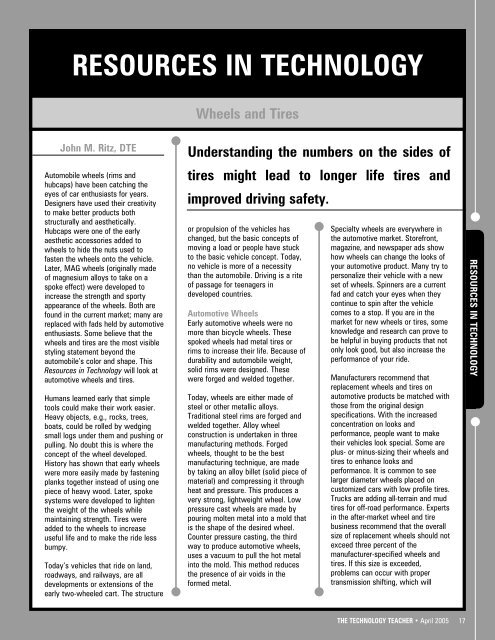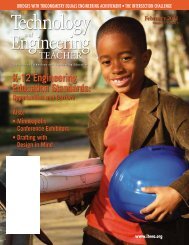Teaching Elements and Principles of Bridge Design - International ...
Teaching Elements and Principles of Bridge Design - International ...
Teaching Elements and Principles of Bridge Design - International ...
Create successful ePaper yourself
Turn your PDF publications into a flip-book with our unique Google optimized e-Paper software.
RESOURCES IN TECHNOLOGY<br />
RESOURCES IN TECHNOLOGY<br />
Wheels <strong>and</strong> Tires<br />
John M. Ritz, DTE<br />
Automobile wheels (rims <strong>and</strong><br />
hubcaps) have been catching the<br />
eyes <strong>of</strong> car enthusiasts for years.<br />
<strong>Design</strong>ers have used their creativity<br />
to make better products both<br />
structurally <strong>and</strong> aesthetically.<br />
Hubcaps were one <strong>of</strong> the early<br />
aesthetic accessories added to<br />
wheels to hide the nuts used to<br />
fasten the wheels onto the vehicle.<br />
Later, MAG wheels (originally made<br />
<strong>of</strong> magnesium alloys to take on a<br />
spoke effect) were developed to<br />
increase the strength <strong>and</strong> sporty<br />
appearance <strong>of</strong> the wheels. Both are<br />
found in the current market; many are<br />
replaced with fads held by automotive<br />
enthusiasts. Some believe that the<br />
wheels <strong>and</strong> tires are the most visible<br />
styling statement beyond the<br />
automobile’s color <strong>and</strong> shape. This<br />
Resources in Technology will look at<br />
automotive wheels <strong>and</strong> tires.<br />
Humans learned early that simple<br />
tools could make their work easier.<br />
Heavy objects, e.g., rocks, trees,<br />
boats, could be rolled by wedging<br />
small logs under them <strong>and</strong> pushing or<br />
pulling. No doubt this is where the<br />
concept <strong>of</strong> the wheel developed.<br />
History has shown that early wheels<br />
were more easily made by fastening<br />
planks together instead <strong>of</strong> using one<br />
piece <strong>of</strong> heavy wood. Later, spoke<br />
systems were developed to lighten<br />
the weight <strong>of</strong> the wheels while<br />
maintaining strength. Tires were<br />
added to the wheels to increase<br />
useful life <strong>and</strong> to make the ride less<br />
bumpy.<br />
Today’s vehicles that ride on l<strong>and</strong>,<br />
roadways, <strong>and</strong> railways, are all<br />
developments or extensions <strong>of</strong> the<br />
early two-wheeled cart. The structure<br />
Underst<strong>and</strong>ing the numbers on the sides <strong>of</strong><br />
tires might lead to longer life tires <strong>and</strong><br />
improved driving safety.<br />
or propulsion <strong>of</strong> the vehicles has<br />
changed, but the basic concepts <strong>of</strong><br />
moving a load or people have stuck<br />
to the basic vehicle concept. Today,<br />
no vehicle is more <strong>of</strong> a necessity<br />
than the automobile. Driving is a rite<br />
<strong>of</strong> passage for teenagers in<br />
developed countries.<br />
Automotive Wheels<br />
Early automotive wheels were no<br />
more than bicycle wheels. These<br />
spoked wheels had metal tires or<br />
rims to increase their life. Because <strong>of</strong><br />
durability <strong>and</strong> automobile weight,<br />
solid rims were designed. These<br />
were forged <strong>and</strong> welded together.<br />
Today, wheels are either made <strong>of</strong><br />
steel or other metallic alloys.<br />
Traditional steel rims are forged <strong>and</strong><br />
welded together. Alloy wheel<br />
construction is undertaken in three<br />
manufacturing methods. Forged<br />
wheels, thought to be the best<br />
manufacturing technique, are made<br />
by taking an alloy billet (solid piece <strong>of</strong><br />
material) <strong>and</strong> compressing it through<br />
heat <strong>and</strong> pressure. This produces a<br />
very strong, lightweight wheel. Low<br />
pressure cast wheels are made by<br />
pouring molten metal into a mold that<br />
is the shape <strong>of</strong> the desired wheel.<br />
Counter pressure casting, the third<br />
way to produce automotive wheels,<br />
uses a vacuum to pull the hot metal<br />
into the mold. This method reduces<br />
the presence <strong>of</strong> air voids in the<br />
formed metal.<br />
Specialty wheels are everywhere in<br />
the automotive market. Storefront,<br />
magazine, <strong>and</strong> newspaper ads show<br />
how wheels can change the looks <strong>of</strong><br />
your automotive product. Many try to<br />
personalize their vehicle with a new<br />
set <strong>of</strong> wheels. Spinners are a current<br />
fad <strong>and</strong> catch your eyes when they<br />
continue to spin after the vehicle<br />
comes to a stop. If you are in the<br />
market for new wheels or tires, some<br />
knowledge <strong>and</strong> research can prove to<br />
be helpful in buying products that not<br />
only look good, but also increase the<br />
performance <strong>of</strong> your ride.<br />
Manufacturers recommend that<br />
replacement wheels <strong>and</strong> tires on<br />
automotive products be matched with<br />
those from the original design<br />
specifications. With the increased<br />
concentration on looks <strong>and</strong><br />
performance, people want to make<br />
their vehicles look special. Some are<br />
plus- or minus-sizing their wheels <strong>and</strong><br />
tires to enhance looks <strong>and</strong><br />
performance. It is common to see<br />
larger diameter wheels placed on<br />
customized cars with low pr<strong>of</strong>ile tires.<br />
Trucks are adding all-terrain <strong>and</strong> mud<br />
tires for <strong>of</strong>f-road performance. Experts<br />
in the after-market wheel <strong>and</strong> tire<br />
business recommend that the overall<br />
size <strong>of</strong> replacement wheels should not<br />
exceed three percent <strong>of</strong> the<br />
manufacturer-specified wheels <strong>and</strong><br />
tires. If this size is exceeded,<br />
problems can occur with proper<br />
transmission shifting, which will<br />
THE TECHNOLOGY TEACHER • April 2005 17
















